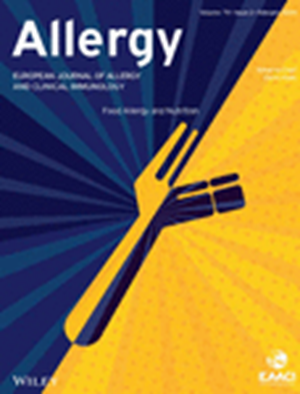Diagnosis of Quinolone Hypersensitivity: An EAACI Position Paper.
IF 12
1区 医学
Q1 ALLERGY
引用次数: 0
Abstract
Hypersensitivity reactions to quinolones (QHRs) have been increasing in frequency, thus classifying them as the second most frequently implicated class of antibiotics in hypersensitivity reactions (HRs). It is noteworthy that quinolones (Qs) have been observed to predominantly trigger immediate hypersensitivity reactions (IHRs). These reactions are categorized as either IgE-mediated or non-IgE-mediated, attributable to the off-target occupation of the recently described receptor, Mas-related G-protein coupled receptor member X2 (MRGPRX2), on effector cells. The increasing trend of HRs underscores the necessity for enhanced diagnostic and management strategies. The present position paper aims to shed light on the key mechanisms involved in immediate and non-immediate QHRs. The clinical spectrum of these reactions is discussed, as well as the utility of skin tests, in vitro diagnostic tests, and drug provocation tests in diagnosis. A further focal point of this study is the analysis of cross-reactivity between various Qs. The paper concludes with the presentation of diagnostic algorithms for both immediate and non-immediate QHRs. The paper's findings aid clinical practice for QHRs and address unmet needs, which should stimulate more in-depth investigations into the mechanisms and clinical practice of QHRs.喹诺酮类药物过敏的诊断:EAACI立场文件。
喹诺酮类药物的超敏反应(QHRs)频率不断增加,因此将其归类为超敏反应(HRs)中第二常见的抗生素类别。值得注意的是,喹诺酮类药物(Qs)已被观察到主要引发立即超敏反应(IHRs)。这些反应被归类为ige介导或非ige介导,归因于最近描述的受体,mas相关g蛋白偶联受体成员X2 (MRGPRX2)在效应细胞上的脱靶占领。hr的增加趋势强调了加强诊断和管理策略的必要性。本立场文件的目的是阐明即时和非即时质量准则所涉及的主要机制。讨论了这些反应的临床谱,以及皮肤试验、体外诊断试验和药物激发试验在诊断中的应用。本研究的另一个重点是分析不同q之间的交叉反应性。本文最后给出了即时和非即时qhr的诊断算法。本文的研究结果有助于QHRs的临床实践,并解决了尚未满足的需求,应促进对QHRs的机制和临床实践进行更深入的研究。
本文章由计算机程序翻译,如有差异,请以英文原文为准。
求助全文
约1分钟内获得全文
求助全文
来源期刊

Allergy
医学-过敏
CiteScore
26.10
自引率
9.70%
发文量
393
审稿时长
2 months
期刊介绍:
Allergy is an international and multidisciplinary journal that aims to advance, impact, and communicate all aspects of the discipline of Allergy/Immunology. It publishes original articles, reviews, position papers, guidelines, editorials, news and commentaries, letters to the editors, and correspondences. The journal accepts articles based on their scientific merit and quality.
Allergy seeks to maintain contact between basic and clinical Allergy/Immunology and encourages contributions from contributors and readers from all countries. In addition to its publication, Allergy also provides abstracting and indexing information. Some of the databases that include Allergy abstracts are Abstracts on Hygiene & Communicable Disease, Academic Search Alumni Edition, AgBiotech News & Information, AGRICOLA Database, Biological Abstracts, PubMed Dietary Supplement Subset, and Global Health, among others.
 求助内容:
求助内容: 应助结果提醒方式:
应助结果提醒方式:


